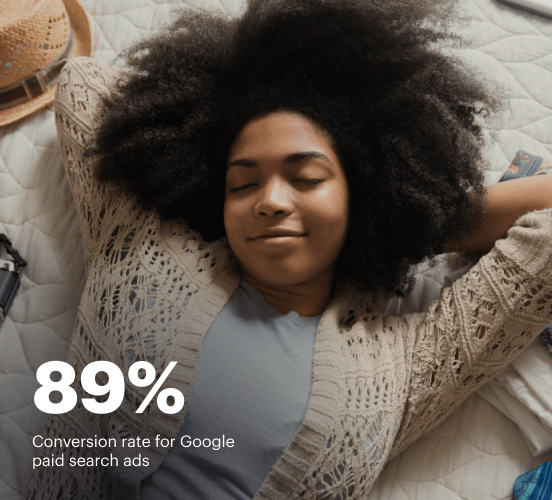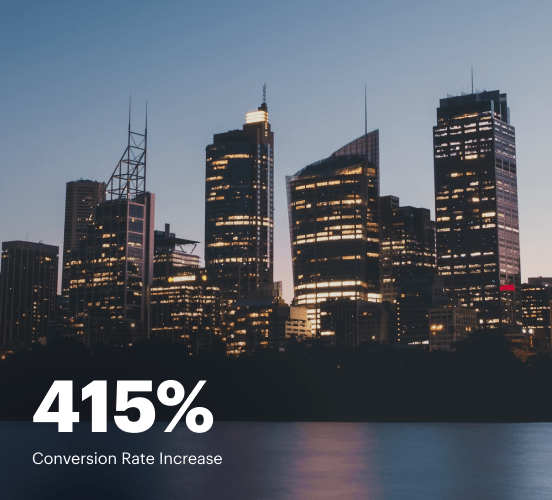How Act-On vs. WordPress vs. Instapage stack up against each other
Compare Instapage with Act-On and WordPress to create high-converting landing pages. With personalization, optimization, and collaboration tools, Instapage helps you deliver experiences that drive results.
Get startedSee how Instapage stacks up against the competition
| Feature | Instapage | Other builders |
| Drag-and-Drop Tools | ||
| Conversion-optimized templates | ||
| Manual and AI-powered A/B Tests | ||
| AI content suggestions | ||
| Popups and sticky bars | ||
| Canvas and grid blocks | ||
| Reusable and global elements | ||
| Form and popup builders | ||
| Built-in Heatmaps | ||
| Central analytics dashboard | ||
| Ad-to-page personalization and collections | ||
| Contacts, lists, and email | ||
| Dedicated, full-service CRO experts | ||
| Enterprise-ready platform |
Leading the way in building high-performing landing pages





Why Instapage is the smarter choice for your campaigns
Get everything you need to build, scale, and optimize high-converting landing pages—without coding.

Easier page building without coding
Instapage offers a flexible and seamless page creation experience with a library of 500+ conversion-focused layouts, Instablocks®, a drag-and-drop builder, and AI content generation. With technologies like Thor Render Engine®, you can create on-brand, mobile-responsive landing pages that load quickly and start converting during initial visitor clicks.

More insights — better results
Instapage lets you see in detail how each landing page experience and variation is performing so you can make targeted changes that boost page conversions. Use heatmaps for a better understanding of on-page activities, run A/B tests and AI-assisted experiments, and then track and evaluate results within robust analytics dashboards.

More personalized experiences
Instapage lets you quickly create high-performing landing pages tailored to each of your ad campaigns. Deliver personalized experiences for distinct audiences using dynamic text replacement. Effortlessly align specific advertisements to unique pages with AdMaps. Monitor audience-level metrics using our advanced data tools.

Built-in collaboration
Instapage collaboration capabilities bring your entire team together to speed up the process of landing page review, approval, and launch. No more frustrating and unnecessary revisions or edits scattered across emails. Provide instant feedback, conduct real-time page edits, and securely share your pages with outside stakeholders.

Free up time for your business
Invest time into business growth, not busy work. Launch landing pages faster with reusable forms and templates. Build once, reuse forever.
Explore all integrations






Easier page building without coding
Instapage offers a flexible and seamless page creation experience with a library of 500+ conversion-focused layouts, Instablocks®, a drag-and-drop builder, and AI content generation. With technologies like Thor Render Engine®, you can create on-brand, mobile-responsive landing pages that load quickly and start converting during initial visitor clicks.
More insights — better results
Instapage lets you see in detail how each landing page experience and variation is performing so you can make targeted changes that boost page conversions. Use heatmaps for a better understanding of on-page activities, run A/B tests and AI-assisted experiments, and then track and evaluate results within robust analytics dashboards.
More personalized experiences
Instapage lets you quickly create high-performing landing pages tailored to each of your ad campaigns. Deliver personalized experiences for distinct audiences using dynamic text replacement. Effortlessly align specific advertisements to unique pages with AdMaps. Monitor audience-level metrics using our advanced data tools.
Built-in collaboration
Instapage collaboration capabilities bring your entire team together to speed up the process of landing page review, approval, and launch. No more frustrating and unnecessary revisions or edits scattered across emails. Provide instant feedback, conduct real-time page edits, and securely share your pages with outside stakeholders.
Free up time for your business
Invest time into business growth, not busy work. Launch landing pages faster with reusable forms and templates. Build once, reuse forever.
Explore all integrationsGet started with Instapage in a few steps
-
Create your Instapage account
Start with Instapage by signing up via Google or your email. You'll get access to a free 14-day trial to discover Instapage capabilities. Feel free to cancel anytime during the 14-day trial if you decide that our product is not suitable for your business. -
Build and personalize your page
Create your first landing page from scratch or choose a template from 500+ customizable layouts. Use the drag-and-drop builder to add page elements, fonts, and backgrounds, refine content with AI, or add custom HTML, Javascript, and CSS. -
Review and make edits
Collaborate on page designs and streamline review processes. Invite your team members and stakeholders to review, edit, and provide feedback on your landing page. Collaborate knowing your page is confidential and only accessible to authorized users. -
Publish and track page performance
Publish your page to a domain or custom URL. Connect your pages to the ads you've created and track page performance within the analytics dashboard, run A/B tests and AI experiments, analyze results, and continuously optimize your landing page to maintain high conversions.
Instapage vs. Act-On vs. WordPress – The Ultimate Showdown
Choosing the right landing page builder can feel like assembling a dream team of superheroes for your marketing strategy. Each brings unique powers to the table, designed to tackle the complex challenges of online marketing. In this comparison, we’ll look at three popular platforms that thrive in the competitive landscape of landing page creation: Instapage, Act-On, and WordPress. Through an in-depth analysis, we'll reveal which of these contenders truly deserves the title of champion. As we embark on this journey, we'll highlight how Instapage empowers marketers to reduce costs, grow conversions, and deliver landing page experiences that foster brand trust and customer loyalty. The stakes are high – let’s see who comes out on top! (min: 200 words, add small paragraphs about the significance of selecting a landing page builder, the impact on marketing strategies, and the quest for high conversion rates.)
Meet the Competitors: Instapage, Act-On, and WordPress
In one corner, we have Instapage, the heavyweight champion known for its focus on conversion optimization and seamless user experiences. With powerful analytics and robust A/B testing capabilities, Instapage supports marketers looking to enhance their landing page effectiveness. In the opposite corner stands Act-On, a well-rounded platform celebrated for its automation prowess and lead nurturing features. This tool offers a comprehensive suite for marketers seeking to perform advanced campaign management and analysis. Lastly, there’s WordPress, the versatile giant of website creation. While primarily a content management system, WordPress offers numerous plugins and themes that enable users to create custom landing pages. Each platform has its own niche, making them formidable opponents. (min: 200 words, add small paragraphs discussing the origins of each platform, their typical user base, and the types of businesses that commonly benefit from their offerings.)
Round One - Feature Showdown
Template Options and User-Friendliness
When it comes to features, template variety and ease of use are critical factors in choosing a landing page builder. Instapage stands out, offering a vast selection of high-converting templates that cater to various industries. Users can easily tweak templates and personalize them to match their branding, making setup a breeze. In contrast, Act-On offers fewer templates but provides customizable options that integrate well with their marketing tools. However, some users find the interface less intuitive, requiring additional time for familiarization. On the other hand, WordPress excels in offering an expansive library of themes. With countless plugins available, users can create virtually any type of landing page, but this can lead to a steeper learning curve for newcomers. (min: 200 words, add small paragraphs discussing how intuitive user interfaces can impact marketers' productivity, the importance of customizable templates for branding, and how varying experience levels influence user choices.)
Instapage: Your Partner for High Conversions
Instapage takes center stage with its unmatched customization capabilities and cutting-edge conversion optimization tools. Its drag-and-drop builder allows marketers to create landing pages that not only look stunning but also are strategically designed for high conversion rates. Instapage integrates seamlessly with various marketing tools, providing advanced analytics that help users fine-tune their campaigns in real-time. Furthermore, with unique features like heatmaps and A/B testing, Instapage empowers marketers to make data-driven decisions. The platform focuses on delivering relevant landing page experiences that enhance brand trust and customer loyalty, making it more than just a tool; it's a partner in achieving marketing success. (min: 200 words, elaborate on specific features like the ability to clone pages, dynamic text replacement, and how these cater to different marketing strategies.)
Round Two - Navigating Speed and Performance
In the digital world, speed is king. A fast-loading landing page can mean the difference between a customer conversion or a quick bounce. Think of it like waiting in line at your favorite coffee shop – you expect quick service, and a long wait can sour your mood. Similarly, if a landing page doesn’t load quickly, visitors will likely lose interest before engaging with your content. Each contender approaches speed differently, which directly affects user experience. Let’s break down how each platform performs in this critical area.
Instapage Advantages:
- Optimized for fast loading times due to its lightweight framework.
- Built-in performance analytics to monitor page speed.
- CDN technology that enhances speed worldwide.
- Responsive design ensuring fast load times on all devices.
Act-On Advantages:
- Integrated with automation tools for quick data processing.
- Server performance is tailored for marketing campaigns.
- Responsive pages that adapt quickly for mobile users.
WordPress Advantages:
- Customization options that allow optimization for speed.
- Plugins like caching engines to enhance performance.
- Flexibility to choose hosting plans for speed optimization.
- Extensive community support for troubleshooting speed issues.
In summary, each platform holds its own in terms of speed and performance. However, when all factors are considered, Instapage consistently leads the charge, ensuring users enjoy fast and reliable access to their landing pages, which is vital for converting visitors into loyal customers.
Round Three - Usability and Learning Curve
Usability varies greatly across these platforms, affecting how marketers interact with them. Instapage shines with its drag-and-drop functionality, allowing users to create stunning pages even with limited technical skills. It offers plenty of guidance, so beginners can quickly gain confidence. Act-On's functionality, while robust, involves a steeper learning curve, which may require additional training or resources to fully utilize its capabilities. Conversely, WordPress can be both a boon and a bane. The sheer number of available plugins may overwhelm users, but those willing to invest time in learning can reap incredible rewards. All three platforms cater to different skill levels, ensuring that marketers can find their footing and progress toward proficiency no matter where they start. (min: 200 words, add small paragraphs explaining how user documentation and online support impact the learning journey for new users and the benefits of community forums.)
Round Four - Support Services and Community
In the world of tech, customer support is like having a trusted sidekick by your side. Each platform provides a unique approach to assisting users, shaping experiences based on the quality of support available. Instapage offers 24/7 support through live chat, email, and an extensive knowledge base. This ensures that help is close at hand, no matter when it's needed. Act-On also provides robust support features, including a dedicated account manager for enterprise solutions, and thorough documentation. Meanwhile, WordPress boasts a vast community of users, meaning countless forums and tutorials are at your disposal, though direct support may vary based on the hosting provider. Each platform presents distinct support strengths, so users must consider which model best fits their needs for ongoing assistance. (min: 200 words, add small paragraphs discussing experiences from users of each platform and how the quality of support can shape user satisfaction and retention.)
Round Five - Analyzing Pricing Structures
Pricing structures can significantly influence a marketer's choice of platform. Instapage offers a simple tiered pricing model, giving users flexibility according to their budget while maximizing feature access. Act-On's pricing can be on the higher side, reflecting its extensive automation features, but it often provides greater long-term value for established businesses. WordPress is unique, as it's free to use, but costs can arise through hosting, premium themes, and plugins. Therefore, understanding the cost-to-benefit ratio is essential for each user. As we dig deeper into pricing strategies, it's vital to align costs with the unique needs of your business, helping you choose the option that delivers the best value. In conclusion, while all three platforms shine in various aspects, the right fit largely depends on what matters most to you. Whether it’s features, support, or cost, everyone has different needs and priorities. We encourage you to explore Instapage with its complimentary trial to see how it can transform your landing page strategies. (min: 200 words, add small paragraphs about testimonials from users regarding their experience with pricing and value for money.)










